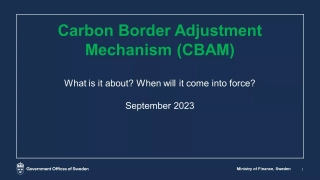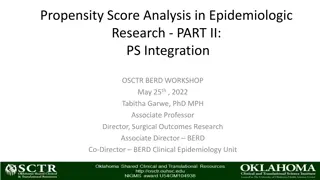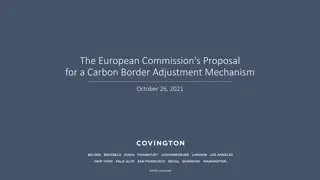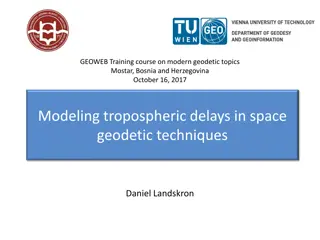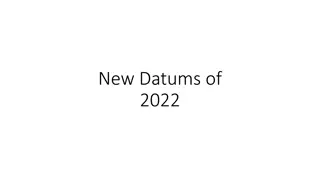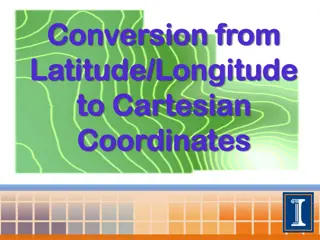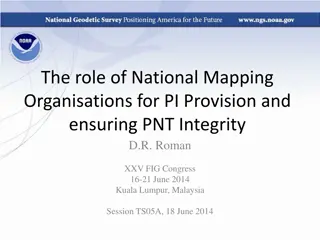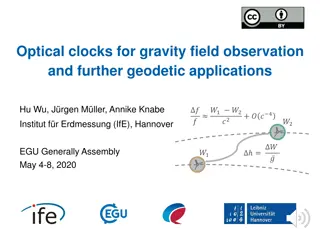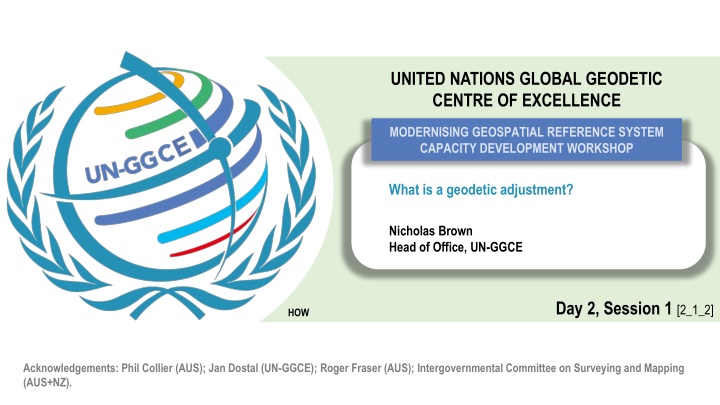
Geodetic Adjustment: Key Concepts and Applications
Discover the essential aspects of geodetic adjustments, including what they are, when to consider them, key elements involved, and the significance of least squares in the process. Learn how geodetic adjustments ensure the accuracy of measurement networks and align data with geodetic reference systems for improved consistency and precision in spatial data.
Download Presentation

Please find below an Image/Link to download the presentation.
The content on the website is provided AS IS for your information and personal use only. It may not be sold, licensed, or shared on other websites without obtaining consent from the author. If you encounter any issues during the download, it is possible that the publisher has removed the file from their server.
You are allowed to download the files provided on this website for personal or commercial use, subject to the condition that they are used lawfully. All files are the property of their respective owners.
The content on the website is provided AS IS for your information and personal use only. It may not be sold, licensed, or shared on other websites without obtaining consent from the author.
E N D
Presentation Transcript
UNITED NATIONS GLOBAL GEODETIC CENTRE OF EXCELLENCE MODERNISING GEOSPATIAL REFERENCE SYSTEM CAPACITY DEVELOPMENT WORKSHOP What is a geodetic adjustment? Nicholas Brown Head of Office, UN-GGCE Day 2, Session 1 [2_1_2] HOW Acknowledgements: Phil Collier (AUS); Jan Dostal (UN-GGCE); Roger Fraser (AUS); Intergovernmental Committee on Surveying and Mapping (AUS+NZ).
When to consider geodetic adjustments Datum not aligned with current version of ITRF Distortion in datum due to geophysical reasons Increase in accuracy of datum is needed for emerging technologies GNSS CORS network has been densified (improved resolution) STRONGER. TOGETHER.
How to align NGD with ITRF - GNSS CORS - GNSS CORS included in regional reference frame STRONGER. TOGETHER.
What is a geodetic adjustment? What are they? A geodetic adjustment is a mathematical process used in to ensure that a network of measurements is as accurate as possible. It involves correcting and optimizing observations, such as angles, distances, and coordinates, to minimize errors and provide the best possible fit for a geodetic model or reference framework. Types of Geodetic Adjustments Local Adjustment: Applied to small-scale networks, like a local land survey. Regional/National Adjustment: Adjusts measurements across larger areas, such as a country, to align with a specific geodetic datum. Global Adjustment: For datasets like those from satellite observations, ensuring consistency across a global reference frame. STRONGER. TOGETHER.
What is a geodetic adjustment? Key Elements of Geodetic Adjustment 1. Observations and Measurements: These can include GNSS data, satellite measurements, leveling data, and traditional surveying observations like distances and angles. 2. Mathematical Model: A geodetic adjustment relies on mathematical models, such as least squares adjustment, to minimize discrepancies between observations and theoretical values. 3. Error Minimization: It accounts for measurement errors (instrumental, observational, or environmental) and distributes these errors across the network in a statistically optimal way. 4. Reference Frames: Adjustments often aim to align the data with a specific geodetic reference system, like WGS84, NAD83, or ETRS89, ensuring consistency across datasets. STRONGER. TOGETHER.
What is least squares? Measured values An optimal estimation technique dealing with: Redundant observations Non-linear observation equations It gives a unique solution from infinite possibilities Minimises the weighted sum of the squared residuals Hence the name least squares It is the best (most statistically likely) solution True length (unknown) STRONGER. TOGETHER.
What is least squares Example: 3+ observations by only 2 unknowns! First-degree polynomial of the form: y y = a x + b = a x + b + e + e is given by: Linear Regression ?1 ?2 ?3 ?1 ?2 ?3 ?11 ?21 ?31 ? ? = + 3 2= ??? ?? observations unknown parameters design matrix error ?=1 Last square condition Design matrix: Organizes the values of explanatory variables (independent variables) for multiple observations in a structured way. The resulting parameters are describing a best fitted line to the observations.
Why geodetic adjustments are needed Measured values Complex, massive, estimation problem Combination of diverse data types Data quality varies greatly (e.g. with survey date) Goal is to improve & quantify coordinate accuracy Least squares approach provides: A statistically optimal combination of data Individual weighting of observations Sophisticated debugging and validation of results Minimal impact on the original observations Reliable accuracy estimates of final coordinates True length (unknown) STRONGER. TOGETHER.
Weighting observations Measured values It s a fact: Not all observations are of the same type Not all observations are of the same precision Most precise observations should have the most influence Assigning an appropriate a priori standard deviation to each observation is the way to achieve this Standard deviations are applied through weighting matrix in least squares True length (unknown) STRONGER. TOGETHER.
Constraining stations Link the adjustment to the national geodetic datum Limit propagation of measurement errors Improve precision of adjusted coordinates Will be sourced from the national geodetic adjustment Will be constrained by variances from the national adjustment STRONGER. TOGETHER.
Levelling Example Start and end point are the same - closed circle. Therefore, the sum of height differences is zero! F A Measurements: = 0 AB= 2.45 BC= -1.10 CD= 0.55 DE = 3.80 EF= -4.10 FA= -1.30 B Inconsistencies: E Error distribution: AB= 2.45 + 0.05 BC= -1.10 + 0.05 CD= 0.55 + 0.05 DE = 3.80 + 0.05 EF= -4.10 + 0.05 FA= -1.30 + 0.05 e = = 0.3 D C ei= 0.3 / 6 = 0.05 = 0
3D Example 2. Regional Reference Frame 1. ITRF 3. Campaign measurements
Recommended procedure (1) The primary purpose of least squares adjustment is to estimate survey control mark coordinates from a set of measurements. In addition to this, least squares provides for the following additional outcomes: the uncertainty of the estimated coordinates; the quality of the survey control network; and the necessary statistics to evaluate the quality of the measurements and the estimated coordinates.
Recommended procedure (2) Types of uncertainty Positional Uncertainty (PU): The uncertainty of the horizontal and/or vertical coordinates of a survey control mark with respect to datum. Relative Uncertainty (RU): The uncertainty between the horizontal and/or vertical coordinates of any two survey control marks. Survey Uncertainty (SU): The uncertainty of the horizontal and/or vertical coordinates of a survey control mark independent of datum.
Recommended procedure (2) 1. All survey control measurements should be corrected for all known calibration corrections and systematic error sources and be accompanied by reliable values of uncertainty (or weights). To test the control survey for errors, redundant measurements sufficient to identify errors shall be used. The larger the degrees of freedom (DoF), the greater confidence can be gained from a survey. 2. A minimally constrained adjustment should be tested using the local test and global test. 3. If required, estimated Survey Uncertainty and associated Relative Uncertainty values should be examined to assess whether the survey has achieved any predefined uncertainty or quality thresholds. 4. When attempting to propagate datum and uncertainty, a fully constrained and appropriately weighted adjustment should be undertaken.
Recommended procedure (3) 5. The fully constrained adjustment should be tested using the local test to verify that the imposed constraints do not result in measurement failure(s). 6. The fully constrained adjustment should be tested using the global test. If this adjustment test fails, the quality of survey measurements and constraints needs to be examined to identify and rectify the cause of failure. 7. If required, estimated PU and associated RU values (or other reliable statistical methods) should be examined to assess whether the survey control network has achieved any predefined uncertainty or quality thresholds.
Evaluating survey uncertainty Statistical tests in a network adjustment are used to assess and/or demonstrate the reliability of a survey control network. The following two tests should be undertaken on both minimally constrained and fully constrained adjustments to evaluate the quality of a survey and the derived results.
Local test A local test is an evaluation procedure performed on individual survey measurements to assess the quality of a measurement and its assumed (or a-priori) uncertainty. To validate each measurement and assumed uncertainty, the size of each adjusted measurement correction should be tested to verify that the correction lies within the upper and lower limits of the specified confidence interval. Such testing should be undertaken to demonstrate that: no gross errors exist within the measurements; all measurements are appropriately weighted; all measurements satisfy any predefined measurement precision criteria; and in the case of constrained adjustment, the imposed constraints are statistically reliable. Local tests should be conducted using the Normal distribution at the 95% confidence level. A correction which exceeds the upper 95% confidence limit indicates a failure and the need to re-evaluate the assumed uncertainty of the measurements and/or imposed constraints.
Global test A global test is an evaluation procedure performed on a least squares adjustment to assess the quality of the survey as a whole. To validate the network as a whole, the sum of the squares of the weighted measurement corrections resulting from the adjustment (the adjustment result) should be tested against the DoF of the network. Testing should be conducted using the Chi-square distribution. If the adjustment result is equal to the DoF, the sigma-zero (or variance factor) will be unity, indicating that the system of survey measurements, uncertainties and constraints is statistically reliable. Values larger than one indicate that one or more of the a-priori measurement uncertainties are over- optimistic, or a larger-than-expected correction has resulted. Values less than one suggest that the measurements were better than assumed by the combined set of measurement uncertainties. Values which exceed the upper confidence limit indicate a failure and the need to re-evaluate the uncertainty of the measurements (via the local test) and/or the uncertainty of the imposed constraints. Whilst it is not always possible, nor essential, to achieve sigma-zero values equal to unity, a pass for both local and global tests is a minimum requirement for demonstrating survey control network reliability.
Example Small, high precision General Purpose Control Survey comprised of GNSS and terrestrial (horizontal angle, vertical angle, slope distance and differential levelling) measurements. The purpose of the survey is to establish four new marks from two GRS marks one survey control mark and one GNSS CORS site. The list of survey control marks and coordinates is shown in Table 1, and the full set of measurements is shown in Table 2 and Table 3. Note that this example is intended to demonstrate a rigorous adjustment and does not promote or infer optimal network design.
Example All GNSS baseline measurements and uncertainties are based upon a two-hour observation period and have been extracted directly from baseline processing software. Each horizontal angle has been reduced from a set of three angle measurements.
Example To cater for the influence of gravity on the angle and spirit levelling measurements, ellipsoid-geoid separations (N) and deflections of the vertical in the prime meridian ( ) and prime vertical ( ) have been interpolated from AUSGeoid09. The respective AUSGeoid09 values for all marks are shown in Table 4.
Minimally constrained adjustment (and global test) In order to verify the GNSS measurement precisions, a minimally constrained adjustment incorporating only the GNSS measurements is executed. Holding survey control mark 22 fixed, the number of measurements is 18 (three per baseline) and the number of unknowns is 9 (three each for marks 23, 24, 26). This results in a DoF of 9. The minimally constrained adjustment at the 95% confidence level yields the results in Table 5.
Minimally constrained adjustment (and local test) Using the local test, each baseline is examined to assess whether the correction exceeds the 95% critical value. A procedure for this test is to examine whether the normalised residual (calculated by dividing the measurement correction by the standard deviation of the correction) exceeds the critical value of the unit Normal distribution at 95%, which is 1.96. From this test, it is discovered that the X and Y components of baseline 1 fail (Table 6) since the normalised residuals exceed 1.96.
Minimally constrained adjustment Having confirmed all GNSS measurements pass the local test, the remaining terrestrial measurements are introduced in order to verify the set of network measurements as a whole. Again, a minimally constrained adjustment is executed holding survey control mark 22 fixed. In this case, the number of measurements is 43 and number of unknowns is 15, which includes the unknown coordinates of marks 21 and 25. This results in a DoF of 28. The minimally constrained adjustment at the 95% confidence level yields the following results in Table 8.
Constrained adjustment (propagate datum and uncertainty) Having confirmed all measurements pass the local test, constraints are imposed on the adjustment to propagate datum and uncertainty from the GRS. The adopted GRS constraints are survey control mark 23 and GNSS CORS site (mark 26). The respective GDA2020 coordinates, AHD height and uncertainties for these marks are shown in Table 10. All uncertainties are at the 1 sigma (68.3% confidence level). For the constrained adjustment, all marks are held free and the constraints are introduced as measurements with their assumed uncertainties. This adjustment yields a pass in the global test and a pass in the local test for all measurements and constraints. As inferred from the lower than expected sigma zero value, the system of measurements were better than indicated by the prescribed uncertainties, and none of the constraints was shown to bias the adjustment in a significant way or to cause any of the measurements to fail.

